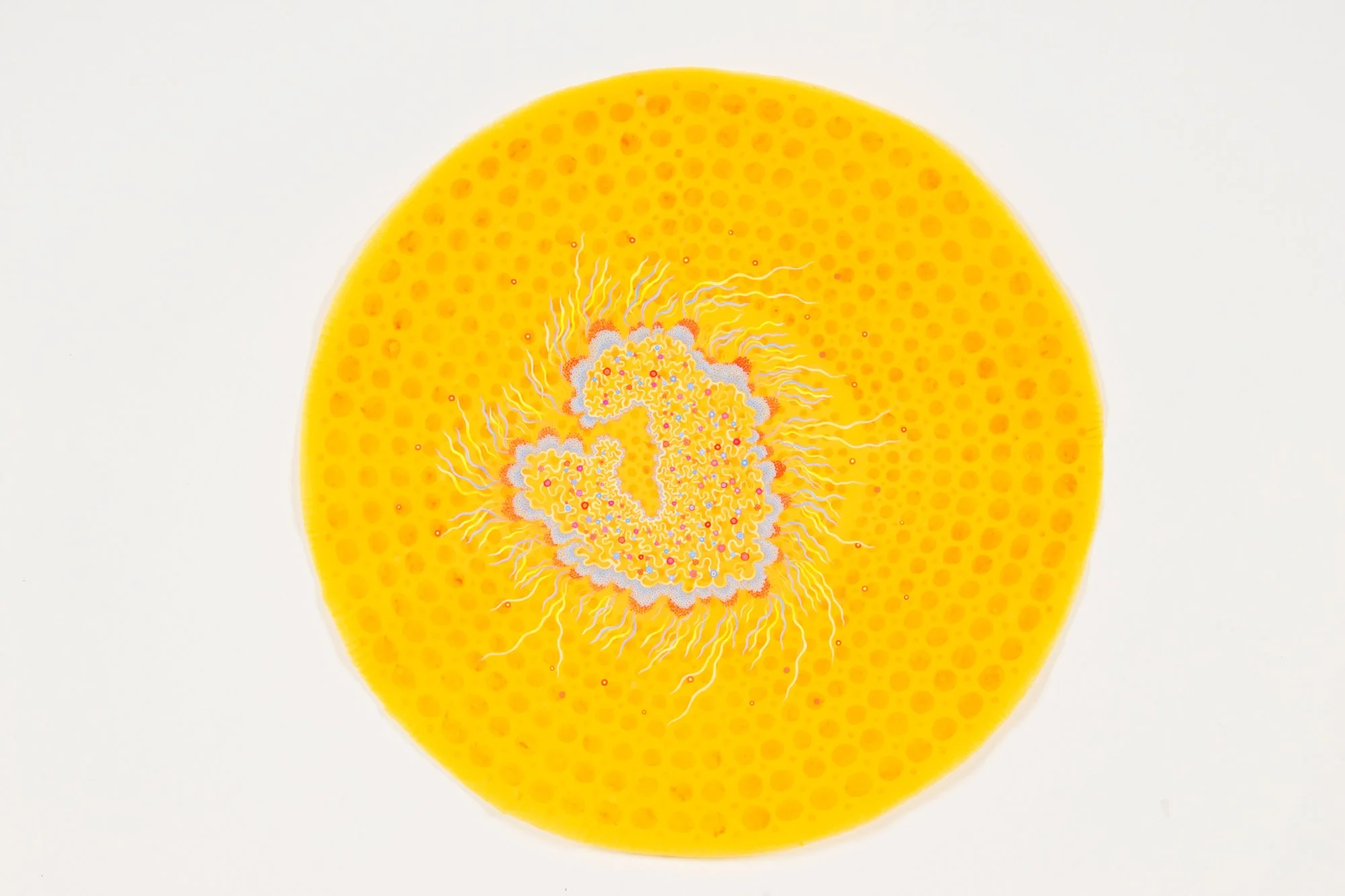Blue (2019)
Blue is a reflection/reinterpretation of the algae used by botanist and photographer Anna Atkins in her book, Photographs of British Algae (1843-45). Using blue pigmented paper pulp, Samour references Atkins’ original ‘blue’ cyanotypes bringing them into a contemporary context. Singed with red and orange hues, the specimens allude to the warming of the oceans and the subsequent red tides that have altered algae since Atkins recorded her specimens over 150 years ago.

Installation view of "Blue," 2019
Pigmented paper pulp, specimen pins
10 ft. x 20 ft. W x 5 in / 304.8 x 609.6 x 12.7 cm
Jamestown Arts Center, Jamestown, RI
Installation view of "Blue," 2019
Detail of "Blue," 2019
Detail of "Blue," 2019
Detail of "Blue," 2019
Detail of "Blue," 2019
Life Inside the Mountain (2010)
Life Inside the Mountain is a tactile visualization of the interior of the Canadian Rockies that were formed by the pushing up of seabeds over a billion years ago. The organisms are covered in eyes, giving life to their fossilized remains and suggesting a permeability of the mountain and contact with the viewer’s gaze. Attached to the wall with specimen pins, they suggest both a natural history collection and illustration.
“I imagined life inside the mountains, fossilized animals and flora pushed up from seabeds and coming alive again; a return to Romanticism when our understanding of the world was predicated on our understanding of nature; a return to the Garden of Eden when man and nature were one. In my invented mountainscape fossils come alive, rock becomes permeable, and hundreds of eyes gaze out at us, as we gaze back at them. I collect these specimens, pinning them down as evidence of their fantastic voyage and proof that I was actually here to imagine it.” — Michelle Samour
Installation view of "Life Inside the Mountain," 2010
Pigmented paper pulp, specimen pins
8 x 20 ft / 2.44 x 6.1 m, dimensions variable
Banff Centre for Arts and Creativity, Canada
Detail of "Life Inside the Mountain," 2010
Detail of "Life Inside the Mountain," 2010
Detail of "Life Inside the Mountain," 2010
Detail of "Life Inside the Mountain," 2010
Detail of "Life Inside the Mountain," 2010
Detail of "Life Inside the Mountain," 2010
Eyes of God (2010-2011)
In the 21st century, advances in science and technology are challenging our religious beliefs and our faith more than ever. Stem cell research and genetic engineering enable us and/or have the potential to clone, pre-determine gender, correct birth defects, develop new vaccines, regenerate nerves and reverse debilitating disease. Add to this the reoccurring debate about the origins of man: evolution versus intelligent design and creationism. Where do science and our religious and faith-based beliefs intersect? Charles Darwin, the British naturalist who became famous for his theories of evolution and natural selection, was a deeply religious man. Was he an anomaly or an example of how science and faith can co-exist?
For thousands of years the ‘Eye of God’ has been used as a symbol of the ‘all-knowing God.’ For example, one of the most extraordinary cosmological events, the solar eclipse, is described by many as the ultimate ‘Eye of God’. The ‘Eye’s’ appearance on our dollar bill and the Great Seal of the United States (In God We trust), its placement within the Masonic pyramid, its illustration on the palm of the hand in numerous cultures, and its appearance on prehistoric earth mounds, affirm it presence as a potent symbol in both our spiritual and lay worlds.
Installation view of "Eyes of God," 2010
Pigmented paper pulp, gouache
10 ft. x 20 ft. W x 5 in. / 304.8 x 609.6 x 12.7 cm
Each piece approx. 7 in / 18 cm DIA,
Houston Center of Contemporary Craft
Installation, SNHU "Eyes of God," 2010
Detail of "Eyes of God," 2010
Detail of "Eyes of God," 2010
Detail of "Eyes of God," 2010
Detail of "Eyes of God," 2010
Detail of "Eyes of God," 2010
Detail of "Eyes of God," 2010
Detail of "Eyes of God," 2010
Detail of "Eyes of God," 2010
Detail of "Eyes of God," 2010
Detail of "Eyes of God," 2010
Detail of "Eyes of God," 2010
Detail of "Eyes of God," 2010
Detail of "Eyes of God," 2010
Detail of "Eyes of God," 2010
Wired Eyes (2010-2014)
In this series, the use of finely processed and pigmented plant fiber creates an organic, translucent and transitory context for investigating the relationship between science, technology and the natural world. The circle becomes a symbol of the ‘all knowing eye,’ the eye of the telescope and microscope, and the physiological eye—our first lens to the visual world. Clusters of ‘cells’, (biologic, geometric, technologic and social) are held together by their close proximity to one another and float on their surfaces, momentarily captured for further investigation. They reference everything from neurons, killer viruses, microscopic radiolarian, the interchange of data by packet switching in Internet communications, to links of fiber-optic cables and wireless connections. The organic becomes over-laid and interchangeable with the technological.
"Wired Eye I," 2014
Gouache on pigmented abaca fiber
24 in / 61 cm in DIA
"Wired Eye II," 2014
Gouache on pigmented abaca fiber
24 in / 61 cm DIA
"Wired Eye III," 2014
Gouache on pigmented abaca fiber
24 in / 61 cm DIA
"Wired Eye IV," 2014
Gouache on pigmented abaca fiber
24 in / 61 cm DIA
"Wired Eye V," 2014
Gouache on pigmented abaca fiber
24 in / 61 cm DIA
"Wired Eye VI," 2014
Gouache on pigmented abaca fiber
24 in / 61 cm DIA
"Wired Eye VII," 2014
Gouache on pigmented abaca fiber
24 in / 61 cm DIA
Detail of "Wired Eye III," 2014
Detail of "Wired Eye IV," 2014
Detail of "Wired Eye V," 2014
Detail of "Wired Eye I," 2014
Detail of "Wired Eye II," 2014
Detail of "Wired Eye VI," 2014
Detail of "Wired Eye VII," 2014









































